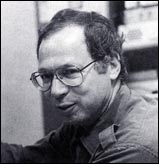Are you a journalist? Please sign up here for our press releases
Subscribe to our monthly newsletter:

An article reviewing the development of man's understanding of vision, which recently appeared in the Journal of NIH Research, begins with Plato's theory of "visual fire" and ends with elucidation of functional organization in the visual cortex of the brain by Prof. Amiram Grinvald of the Institute's Department of Neurobiology.
According to the article, the first detailed theory of vision was propounded by early Greek philosophers such as Plato, who held that a ray of visual fire emanated from each eye and mixed with light to produce an invisible structure between the eye and an observed object. Galen, a second-century Roman physician, suggested that the brain is essential for consciousness and perception. In 1490, da Vinci reiterated Galen's concept that the eyes communicate directly with the brain. This long line of research, pursued by many scientists, was followed by the seminal work of Cajal and that of Hubel and Wiesel, who won Nobel Prizes for their contribution to brain research. And the most recent advances, according to the Journal, have been made by Prof. Gary Blasdel of the Harvard Medical School and the Weizmann's Prof. Grinvald.
"Independently," the Journal reports, "since 1986 they have used cameras to measure changes in the activity of neurons in exposed surfaces of the visual cortex as animals view lines of different orientations. They mapped the location of many different orientation columns on the surface of the primary visual cortex in a single test animal, at a higher resolution than is possible with standard methods of labeling."
The optical imaging technique that they used, which allows the direct visualization of electrical activity in the living brain, was developed by Grinvald at the Weizmann Institute in 1984. In enables scientists to visualize the intricate functional architecture of the brain, that is, the layout across the cortical surface of brain cells involved in distinct processing tasks. Optical imaging of functional borders is also being applied by neurosurgeons to minimize damage during tumor removal. The technique grew out of the 1968 pioneering work of Tasaki and Cohen showing that electrical activity of single nerve cells can be monitored by light.
Referring specifically to Grinvald's work, the Journal states: "He showed that the orientation columns are arranged in radially symmetric, fan-like structures he called 'pinwheels'. In this arrangement, a set of orientation columns intersects at the center of the pinwheel." This information sheds new light on the functional organization of the nerve cells responsible for the perception of object shapes. This work was done together with Prof. Tobias Bonhoeffer at Rockefeller University.
Thanks largely to these investigations, the NIH Journal concludes, "researchers currently understand the primary visual cortex better than any other part of the brain."
Prof. Grinvald, who holds the Helen and Norman Asher Chair in Brain Research, is the director of the Grodetsky Center for the Research of Higher Brain Functions.